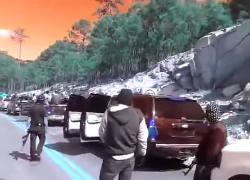A new video of a caravan of hitmen in northern Mexican offers a rare view of the fighting forces of Mexico’s criminal organizations, and may reflect the ongoing incursion of organized crime into mining, hydrocarbon exploration, and other industries.
The video uploaded to YouTube (see below) last week features an unidentified cameraman walking alongside a resting convoy of about 15 trucks and SUVs, all of which were carrying well armed men. The cameraman repeated the phrase “Animo, sicarios” –which, translated loosely, means “Let’s go get ‘em, hitmen” — on various occasions, and the group appeared to be pausing on its way to battle.
That is because they were. Proceso reported that some of the vehicles in the video, which was filmed from a highway in Chihuahua’s Sierra Tarahumara region, were recovered from the scene of a November 2014 shootout in Samachique, Chihuahua, which ended with the death of dozens, although only eight bodies were recovered by authorities. Some of the men who appeared were reportedly also killed in a March 2015 gunfight in a nearby ranch.
While it is unclear which group the gunmen represented, the battles to which they have been linked pitted Gente Nueva, the Sinaloa Cartel’s local allies, against La Linea, the fighting force aligned with the Juarez Cartel during the last decade.

InSight Crime Analysis
The video and the stories around the group are noteworthy for a number of reasons. They show that La Linea, whose erstwhile patron has been arrested and which has suffered from years of government pursuit, remains a significant actor in a key section of the country. (The mountainous regions of western Chihuahua include productive areas of cultivation for poppy and marijuana.) The group is still participating in massive engagements, despite having lost its most important base of operations in Juarez.
While the Sinaloa Cartel was credited with defeating La Linea and its allies in Juarez, the group, which has also suffered its own setbacks, has been unable to stamp out all opposition. Reports of the Sinaloa Cartel fighting with enemies — often weakened adversaries all but left for dead, like the Beltran Leyva Organization (BLO) and La Linea — in the mountainous sections of Sinaloa, Chihuahua, and Durango have been common.
SEE ALSO: Mexico News and Profiles
The video also offers a clear demonstration of Mexican criminal groups’ level of impunity, sophistication, and firepower. The approximately 15 vehicles collectively held perhaps 50 individuals, equivalent to a large army platoon. As noted above, most were heavily armed. One fighter appeared to be toting a .50 caliber machine gun outfitted with a bipod, and the video seemed to indicate that a team was dedicated to manning the gun.
Despite the conspicuousness that a convoy of machine-gun toting hitmen parked along a highway inherently implies, none of the men appeared particularly worried about being detected. On the contrary, the men operated as though they were the owners of the territory, despite having illegal weapons and committing other violations. Such boldness speaks to an expectation of impunity among criminal groups that is at the heart of their threat to Mexico.
Some analyses of the episode have theorized that the incidents are tied to the rising interest of organized crime to resource extraction in the region. Journalist Shannon Young, a foreign correspondent based in Mexico, pointed out that mining and energy interests in the Sierra Tarahumara, as in much of the nation, have seen a substantial uptick in the involvement of criminal organizations. Massive shows of force and the collusion of local authorities, both of which were implicit or explicit in the video, have been vital to gangs’ muscling in on the sorts of big, politically connected businesses that tend to manage resource concessions.
SEE ALSO: Coverage of Mining
It’s not clear that the individuals in the video nor the subsequent firefights had any direct tie to natural resource disputes, but the problem in Mexico, grown more severe in recent years. In a recent interview with the Wall Street Journal, Manuel Reyes, president of the Mexican Association of Mining, Metallurgical, and Geological Engineers, said that organized crime has “besieged” his industry. The newly formed gendarmerie, a centerpiece of President Enrique Peña Nieto’s security policy, was redesigned specifically to focus on mining and other strategic industries.
On many occasions, the tensions between criminal groups and mining companies have led to violence or some sort of accommodation. One of the most prominent such cases was the Knights Templars’ alleged murder in 2013 of Virgilio Camacho, an executive at ArcelorMittal, the steel producer with a massive plant in Lazaro Cardenas. More recently, Canadian mine owner Rob McEwan, whose Sinaloa mines were the target of a successful gold theft worth more than $8 million earlier this year, spoke candidly of his firm’s collaborative relationship with local drug traffickers.
In Guerrero, currently one of Mexico’s most dangerous regions, criminal groups’ attacks on mines have grown more frequent as well. In February, 12 employees of the mine Media Luna were reportedly kidnapped. One month later, four Guerrero-based employees of the Canadian firm Goldcorp were also kidnapped. One was subsequently released, while the three others were tortured and killed.

